kottke.org posts about NYC
I was just wondering this the other day…where can you get good nachos in NYC? Serious Eats investigates.
Not only are they delicious (when made right, and we’ll get to that), but they practically create their own conversation. Everybody has an opinion on how chunky the guacamole should be. We all have feelings about whether chili or beans make a better topping. Who hasn’t considered whether or not they’d ever prefer a fresh jalape~no to a pickled one, and who hasn’t considered de-friending a friend who dares to express a preference for fresh over pickled? And then there’s the ever-raging debate of cheese sauce vs. melted cheese, a subject you might actually consider not broaching in mixed company.
Great post by Nick Carr on Scouting New York comparing the movie locations in The Godfather to what they look like today.
Because the film is a period piece, The Godfather actually presents a fascinating record of what 1940s-era New York City locations still existed in the early-1970s. Sadly, many of them are now gone. What still remains? Let’s take a closer look.
Gothamist uncovered a NYC guide book from the 1920s called Valentine’s City of New York: A Guide Book. Some of the tips include:
Don’t take the recommendation of strangers regarding hotels… Don’t get too friendly with plausible strangers.
Don’t gape at women smoking cigarettes in restaurants. They are harmless and respectable. They are also “smart.”
Don’t forget to tip. Tip early and tip often.
(via @DavidGrann)
From photographer Greg Alessandrini, a collection of photos of diners in New York City taken in the 1990s. I was pleased to see a shot of Jones Diner, which I ate at several months before moving to NYC:
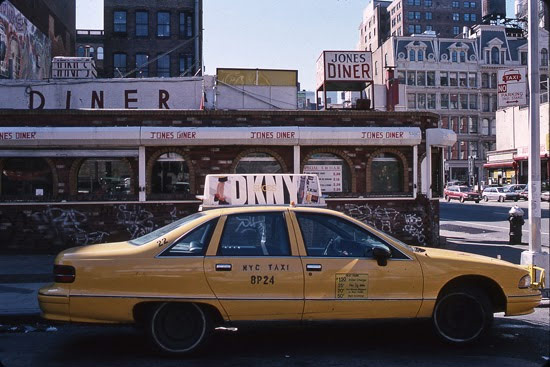
It closed shortly before we moved and I never got to eat there again. At the time, word was some condos were being built on the site, but it took ten years for construction to start. What a waste.
BTW, the rest of Alessandrini’s site is well worth a look…hundreds and possibly thousands of photographs of NYC from the 80s and 90s. (via @UnlikelyWorlds)
2004 was a pretty good year for the NYC food scene. Among the openings were The Spotted Pig, Per Se, Momofuku Noodle Bar, and Shake Shack.
If there was a movement taking shape, its key players admit they didn’t notice until after the fact. And many of them spent the year struggling. Mr. Chang was desperate for customers in the early days at Noodle Bar, and kicking himself for having failed to apply for a kitchen job at Per Se or Masa. “I remember thinking very clearly, ‘What am I doing?’ ” he said. ” ‘This is stupid. I should be working at Masa!’ “
In some cases, 2004 was an outright fight. At the Spotted Pig, Mr. Friedman and Ms. Bloomfield, who had arrived from England, envisioned the vibrant boite as “a really cool bar that happened to have food as good as any restaurant in town,” Mr. Friedman said. “Who made the rule that you can’t have a real chef instead of someone who defrosts the frozen French fries?”
In a clip from The Daily Show in August, Jessica Williams completely skewers the Bloomberg administration’s asinine stop-and-frisk policing by advocating for a stop-and-frisk policy for white collar criminals on Wall Street (aka Business Harlem).
[Deleted the embed because of some reports of autoplaying. Why can’t anyone but YT and Vimeo get this right?]
From All-You-Can-Eat Press in Brooklyn, the New York Ramen Map.
Attention noodle lovers: this is your lucky day! Our third publication-the New York Ramen Map-is here !! It features 33 of New York’s most interesting and delicious noodle shops, plus a special glossary and regional map of ramen in Japan.
Not sure I see my favorite place on there. Same folks also do a New York Doughnut Map and a New York Burger Map.
From Freestyle: The Art of the Rhyme, a short clip of a 17-year-old Christopher Wallace (aka Biggie Smalls, aka The Notorious B.I.G.) freestyle rapping on a street corner in Bed Stuy, Brooklyn in 1989.
It’s all there…the talent, the confidence, the skills. Compare with a 17-year-old LL Cool J rapping in a Maine gymnasium in 1985. (via ★interesting)
Update: Biggie was rapping on Bedford Ave between Quincy St and Lexington Ave in Bed-Stuy. Check it out on Google Maps. (thx, debbie)
On the occasion of leaving New York, Rebecca Flint Marx writes about one of her favorite New York City places (Russ & Daughters) and a particular counterman there, Paul.
Being a regular is a funny thing in a big city. Outside, you’re just an anonymous schmo. But if you come inside often enough, each visit starts to feel like a family reunion of sorts; like the extended members of your biological family, the people you encounter will likely be happy enough to see you, though they probably have little idea of who you actually are as a person. But there’s a beauty in deciding how much of yourself to offer as part of the general exchange of money and goods: You can be the thoughtfully curated version of you — the one who always smiles and never has any problems. The one who is a good person simply because she says “please” and “thank you,” exchanges salty banter with the cantankerous counterman, and bakes a cake for the Yom Kippur rush, as I started doing for the staff a few years ago.
What a lovely piece. See also the joys of being a regular.
Flinder Boyd follows streetballer TJ Webster on a cross-country bus trip for an opportunity to play his way onto a team in the prestigious EBC tournament at storied Rucker Park.
Despite his small size and light frame, he carries, like a weapon stashed under a vest, a 38” vertical jump. Along with his self-proclaimed “great” outside jump shot, he knows that during this 20-minute open tryout he’ll have to do enough to impress one of the handful of coaches glaring at him from the stands. They represent teams in the upcoming Entertainer’s Basketball Classic, an eight-week long tournament and the jewel of New York’s basketball summer circuit.
Just two days ago, TJ stepped off a cross-country bus with every penny to his name wedged into the bottom of his bag for a chance to change his life. It’s a long shot; he understands that, and so do the other nine players on the court. There are only two ways to make an EBC team, either by reputation or by being selected after your performance in the open run.
Each year, one, maybe two players, at most will be good enough to be granted a jersey and, in essence, a pass inside the halls of the cathedral of street basketball; a chance to feel the nearly religious power of Rucker Park - the same court that has hosted some of the greatest players to ever play the game.
Sometimes dreams are best kept that way.
Here’s how Balthazar, one of Manhattan’s busiest and most-beloved restaurants, serves 1500 meals every single day.
Roughly one in 10 people who enter Balthazar orders the steak frites. It is far and away the restaurant’s best-selling dish, and Balthazar can sell as many as 200 on a busy day. A plate of steak and potatoes requires a tremendous input of labor if you’re going to charge $38 for it. At a smaller restaurant, cooks are typically responsible for setting up their own mise-en-place — preparing food for their stations — before each service begins, but at Balthazar, things are necessarily more atomized. The fries, for example, go through numerous steps of prep, done by a few different people, before they wind up on a plate.
Step 1 begins at about 6:30 a.m., when Diogene Peralta and Ramon Alvino, the prep cooks in charge of potatoes, each grab a 50-pound case of GPODs, from the Idaho company that sources Russet Burbank potatoes, known for their consistency, and place a massive plastic tub on the floor behind them. This morning, Alvino is flying, his left hand’s fingers imperceptibly rotating the potato between upward strokes of the peeler, blindly flipping the naked spuds over his shoulder into the tub. I pull up my phone’s stopwatch to time him for a minute, treating each potato as a lap: his slowest is 10.7 seconds, his quickest 6.4. Alvino, a shy man from the Dominican Republic, has been doing this same job for 15 years. “Like anything else, it was difficult at first,” he says, but he caught his rhythm after a couple of months. Peralta has been at it for 14 years. Today, they will peel and chip about 600 pounds of potatoes. (Since russet supplies are short in late summer, Balthazar stockpiles thousands of cases of potatoes in a New Jersey warehouse.) Next, they will soak them in water that must be changed three times in order to leach out starch. The potatoes that are peeled today won’t be fried, actually, until tomorrow, and then refried — but that’s another guy’s job.
What an intricately designed system; even the menu is designed to drive profit.
The Roaring Twenties web site is “an interactive exploration of the historical soundscape of New York City”.
The Roaring ‘Twenties website is dedicated to that challenge, attempting to recreate for its listeners not just the sound of the past but also its sonic culture. It offers a sonic time machine; an interactive multimedia environment whereby site visitors can not just hear, but mindfully listen to, the noises of New York City in the late 1920s, a place and time defined by its din.
(via paleofuture)
Jake Dobkin has been doing a series of posts on Gothamist called Ask a Native New Yorker and in the latest installment, he tackles the gentrification of New York City.
All New Yorkers are gentrifiers. Say you’re of Jewish extraction: your forebears gentrified some Irish right out of L.E.S. around the turn of the century. Or maybe you’re Irish, and your ancestors were responsible for gentrifying the marginal land around the Collect Pond in Five Points. Or maybe your family goes all the way back to New Amsterdam and Peter Minuit, the original gentrifier, who gentrified the poor Native Americans right off Manhattan island. No New Yorker, no matter how long their tenure, has the right to point fingers and say to anyone else “the problem started when you arrived here.”
Looks like someone lost their drone in the West Village:
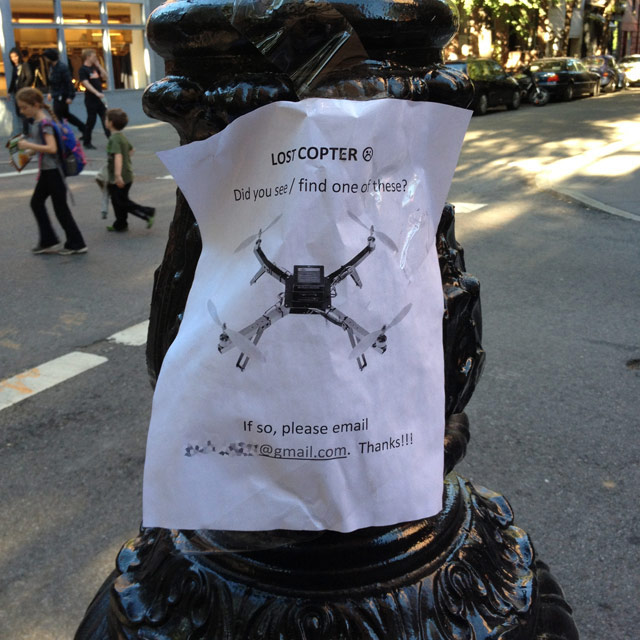
Pretty sure that drones falling from the skies in heavily populated metropolitan areas is going to lead to banning.
Former NY Times restaurant critic Frank Bruni writes about the joys of being a regular at your neighborhood restaurant.
What you have with a restaurant that you visit once or twice is a transaction. What you have with a restaurant that you visit over and over is a relationship.
My wife and I eat out at least once a week and we used to travel all over the city to try all sorts of different places, just-opened hot spots and old favorites alike. It was great. But now we mostly go to a bar/restaurant1 around the corner from where we live and that’s even better. Bruni covers the experience pretty well, but I just wanted to share a couple of seemingly small aspects of being a regular:
1. Our local is popular and always crowded, especially during the dreaded 7-10pm hours and double especially Thu-Sat nights. But even when I go in by myself at a peak time, when the bar’s jam-packed, there’s always a seat for me. It might take a bit, but something opens up and they slot me in, even if I’m only stopping in for a drink and they could seat a two-top for dinner at the bar. (A regular in the hand is worth two in the rush.)
2. This is a totally minor thing but I love it: more than once, I’ve come in early in the evening, had a drink, left without paying to go run an errand or meet someone somewhere else, and then come back later for another drink or dinner and then settle my bill. It’s like having a house account without the house account.
3. Another nice thing about being a regular at a place that values regulars is that you meet the other regulars. This summer I was often left to my own devices for dinner and a couple times a week, I ended up at my local. And almost without exception, I ended up having dinner with someone I’d previously met at the bar. Routinely turning a solo dining experience into dinner with a friend is an amazing accomplishment for a restaurant.
Paul Ford says that the Citi Bike is the perfect post-apocalyptic vehicle.
Citi Bikes thus also seems particularly well-suited for a sort of Hunger Games-style future: 1) The economy crashes utterly 2) poor, hungry people compete in hyperviolent Citi Bike chariot races at Madison Square Garden, now renamed Velodrome 17.
A trundling Citi Bike would make sense in just about any post-apocalyptic or dystopian book or movie. In the post-humanity 1949 George R. Stewart classic Earth Abides, about a Berkeley student who survives a plague, the bikes would have been very practical as people rebuilt society across generations, especially after electricity stopped working. And Walter M. Miller Jr.’s legendary 1960 A Canticle for Leibowitz, about monks rebuilding the world after “the Flame Deluge,” could easily have featured monks pedaling around the empty desert after that deluge. Riding a Citi Bike (likely renamed something like “urbem vehentem”) would probably have been a tremendous, abbot-level privilege, and the repair manual would have been an illuminated manuscript. It’s gotten so that when I ride a Citi Bike I invariably end up thinking of all the buildings with their windows shattered, gray snow falling on people trudging in rags on their way to the rat market to buy a nice rat for Thanksgiving.
Choire Sicha ponders.
But if New York City is better than ever — and we think it is — then why does it suck so bad?
The money, yes. And the cupcakes, and the ATMs, and all these apartments that somehow are in clock towers, which are all also just money. Among the young set, it’s newcomers’ parents paying up at our phantom tollbooth. There is now a class of New Yorkers with the luxury of not just money but also plenty of time. Once you got a crappy coffee at the deli or you didn’t get coffee. Now the city is a wonderland of delicious pour-over. Every day is choose-your-own-adventure when you’re not dying over the rent. Now there’s a substantial population who thinks New York’s a lark, or college 2.0, or an indie-lectual Rumspringa, a lazy not so Grand Tour before packing it in to get married in Dallas. Not to pick on the millennials: The olds aren’t suffering either. Now a vast number of them pretend to live in the city while gardening at their second homes, in the sweet spread from Germantown to Ghent to Kinderhook. The result: New York has fewer who’d bleed for her. Once the city was for people who craved it with the stridency of a young Madonna. The result was entertainment, friction, mayhem, disaster, creation, magic.
(via @tcarmody)
Robin Nagle, the Anthropologist in Residence for the New York City Department of Sanitation, recently wrote a book about the city’s sanitation department. Collectors Weekly has an interview with Nagle about the book and sanitation in general.
Waring also dressed the workers in white, and even his wife said, ‘What, are you crazy?’ But he wanted them to be associated with notions of hygiene. Of course, those in the medical profession wore white, and he understood, quite rightly, that it was an issue of public health and hygiene to keep the street clean. He also put them in the helmets that the police wore to signify authority, and they quickly were nicknamed the White Wings.
These men became heroes because, for the first time in anyone’s memory, they actually cleaned the city. It was a very bright day in the history of the department. Waring was only in office for three years, but after he left, nobody could use the old excuses that Tammany had used to dodge the issue of waste management. They had always said it was too crowded, with too many diverse kinds of people, and never mind that London and Paris and Philadelphia and Boston cleaned their streets. New York was different and it just couldn’t be done. Waring proved them wrong. Rates of preventable disease went down. Mortality rates went down. It also had a ripple effect across all different areas of the city.
Now, NYC is not the cleanest city in the world, not by a long-shot, but it used to be so much worse. In the early 1890s, the streets were literally covered in trash because the Department of Street Cleaning (as it was known then) was so inept; look at the difference made by a 1895 reorganization of the department:

The book trailer for Thomas Pynchon’s new novel is either brilliant or the dumbest thing ever.
Fun fact: the phrase “I don’t even” was invented to react to this video. (via @GreatDismal)
A federal judge ruled this morning that NYC’s controversial stop-and-frisk practice violated the rights of “tens of thousands” of New Yorkers.
In a decision issued on Monday, the judge, Shira A. Scheindlin, ruled that police officers have for years been systematically stopping innocent people in the street without any objective reason to suspect them of wrongdoing. Officers often frisked these people, usually young minority men, for weapons or searched their pockets for contraband, like drugs, before letting them go, according to the 195-page decision.
These stop-and-frisk episodes, which soared in number over the last decade as crime continued to decline, demonstrated a widespread disregard for the Fourth Amendment, which protects against unreasonable searches and seizures by the government, according to the ruling. It also found violations with the 14th Amendment.
To fix the constitutional violations, Judge Scheindlin of Federal District Court in Manhattan said she intended to designate an outside lawyer, Peter L. Zimroth, to monitor the Police Department’s compliance with the Constitution.
This is good news. Treating every young black male in the city like a criminal is not a policing strategy and it’s embarrassing it has gone on this long. This kind of thing, along with the recent NSA revelations and other issues, make me wonder if “innocent until proven guilty” is still something the US citizenry and its law enforcement agencies still believe in. (via @beep)
Update: Using data from the last half of 2013, the NY Times says ‘Stop-and-Frisk’ Is All but Gone From New York.
Many who live and work in the neighborhoods say they see scant evidence of change, and some say the police are simply not reporting some or all of their stops. The police did not respond to requests for comment.
But something is clearly different: Misdemeanor drug and weapon charges, the most common arrests to result from a stop, are down considerably. Advocates say misdemeanor marijuana charges, which require that the drug is in plain sight, are a bellwether, because the police ordered thousands to empty pockets, and arrested them.
I’ll reserve judgement until the numbers from 2014 are in, particularly those post-Bloomberg.
In July, Jay Z rapped Picasso Baby at Pace Gallery in NYC for six hours. The fruits of that labor have been condensed by director Mark Romanek into a 10-minute music video that premiered on HBO last night. Here’s the film:
The idea of performance art came to mind. I was aware of Marina Abramovic’s Artist is Present, even though I was in London shooting ‘Never Let Me Go’ and didn’t get to go. And the idea that Jay-Z regularly performs to 60,000 people at a time, I thought, ‘What about performing at one person at a time?’ He absolutely loved it. He interrupted me and said, ‘Hold on! I’ve got chills. That idea is perfect.’ He thinks, like me, that the music video has had its era. I also wanted to make sure we had Marina’s blessing. So she attended the event and took part in the event. She couldn’t have been more happy or enthusiastic about us using her concept and pushing it forward.
Also, somehow, I have never heard Jay Z talk before. That’s his voice?
Museum Hack is offering non-traditional tours of the Metropolitan Museum of Art in NYC.
Join this “Museum Hack” tour to turn one of New York’s most spectacular cultural institutions into a totally unique experience. We will show you the very best and most intriguing that the Metropolitan Museum of Art has on display.
This is not a boring art history lecture. What we offer is a fun, group-oriented VIP tour experience. You will be entertained… and learn a bit along the way. We strive to offer a brand new view of the Met, one that you wouldn’t get by simply visiting the museum on your own.
Great idea. Museum Hack grew out of a smaller effort to Hack the Met.
In 2011, Toyota offered to donate their celebrated business management process to The Food Bank for New York City. After some initial skepticism, the donation has “proved transformative” for the Food Bank.
“They make cars; I run a kitchen,” said Daryl Foriest, director of distribution at the Food Bank’s pantry and soup kitchen in Harlem. “This won’t work.”
When Toyota insisted it would, Mr. Foriest presented the company with a challenge.
“The line of people waiting to eat is too long,” Mr. Foriest said. “Make the line shorter.”
Toyota’s engineers went to work. The kitchen, which can seat 50 people, typically opened for dinner at 4 p.m., and when all the chairs were filled, a line would form outside. Mr. Foriest would wait for enough space to open up to allow 10 people in. The average wait time could be up to an hour and a half.
Toyota made three changes. They eliminated the 10-at-a-time system, allowing diners to flow in one by one as soon as a chair was free. Next, a waiting area was set up inside where people lined up closer to where they would pick up food trays. Finally, an employee was assigned the sole duty of spotting empty seats so they could be filled quickly. The average wait time dropped to 18 minutes and more people were fed.
A very pretty but almost completely useless circular map of the NYC subway.
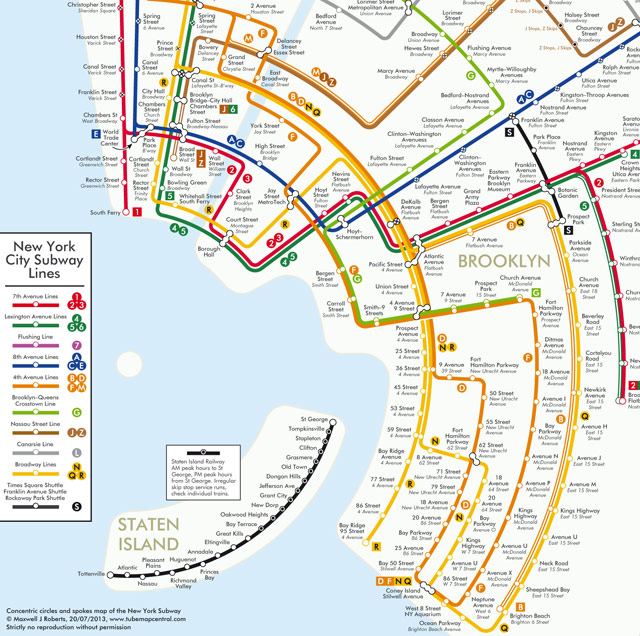
There’s a London Tube version too.
From 1890, a hand-drawn map of Midtown Manhattan “from 34th Street to 59th Street and from 1st Avenue to 6th Avenue”.

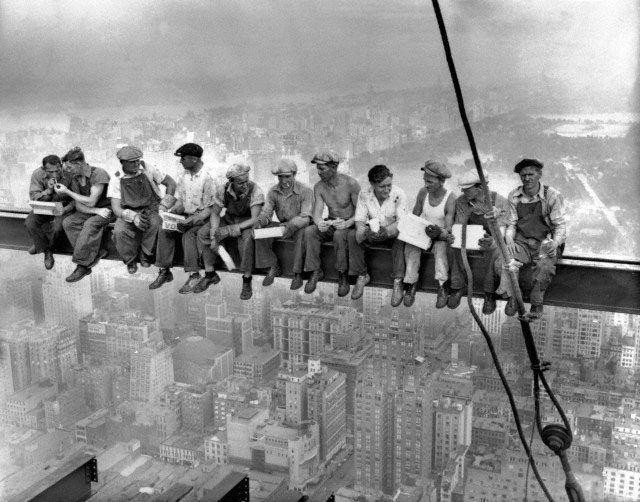
That’s the iconic “Lunch atop a Skyscraper” photo taken in 1932 during the construction of the RCA Building (aka 30 Rock) in NYC. Eleven construction workers eating lunch on a steel girder 840 feet in the air. The shot was a PR stunt to drum up excitement around the near completion of the new skyscraper…no one even knows for sure who took the photo because it was likely a multiple photographer situation. On the same day the lunch photo was taken, some of the same men were photographed taking a nap on the same girder:
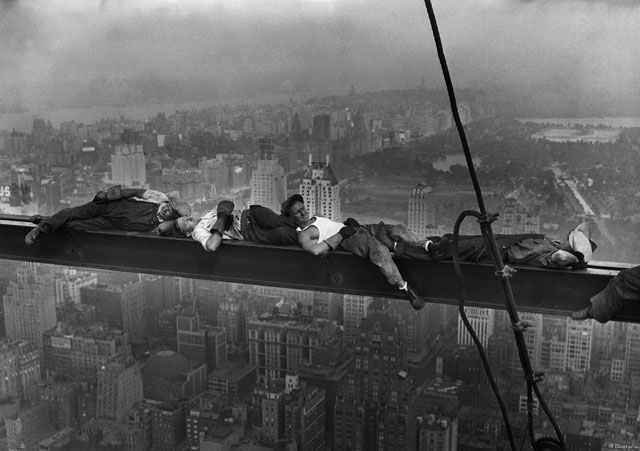
Ah, the good old days, when people used to talk to each other in public rather than looking at their phones or listening to headphones all the time. Except that’s not been the case for awhile as XKCD demonstrates with a series of quotes from various publications dating back to 1871. This is from William Smith’s Morley: Ancient and Modern published in 1886.
With the advent of cheap newspapers and superior means of locomotion… the dreamy quiet old days are over… for men now live think and work at express speed. They have their Mercury or Post laid on their breakfast table in the early morning, and if they are too hurried to snatch from it the news during that meal, they carry it off, to be sulkily read as they travel… leaving them no time to talk with the friend who may share the compartment with them… the hurry and bustle of modern life… lacks the quiet and repose of the period when our forefathers, the day’s work done, took their ease…
In 1946, a young Stanley Kubrick worked as a photographer for Look magazine and took this shot of NYC subway commuters reading newspapers:
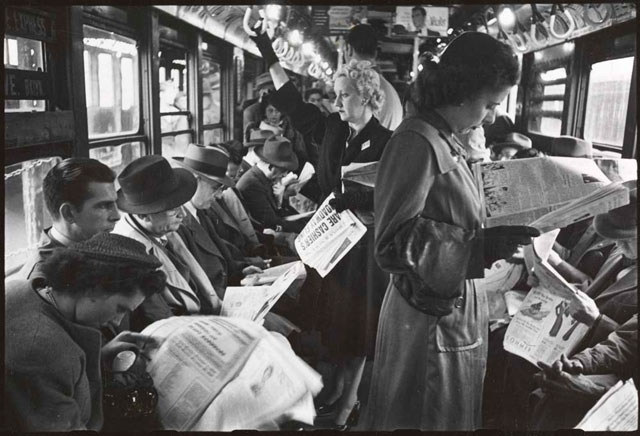
The more things change, etc. More of Kubrick’s subway photography can be found here.
Museum is the world’s smallest museum, located in a small walk-in closet-sized space in Cortlandt Alley between Franklin St & White St in NYC. Collectors Weekly talked with one of the museum’s founders.
In the current season, there’s a collection of toothpaste tubes from around the world. There’s a collection of mutilated U.S. currencies, money that’s counterfeit or real money that’s been scrawled on. There’s a collection from Alvin Goldstein, who was the founder and editor of Screw magazine, who shared with us personal belongings that have stayed with him throughout the narrative of his life. There’s a collection of Disney-themed children’s bulletproof backpacks. They’re things that touch upon something that’s happening in society, things that comment on where we’re at and how we’re thinking and what we’re doing.
Jacob Riis came to NYC in 1870 at the age of 21. He had $40 in his pocket, which he quickly spent. Unemployed, he lived for a time in the city’s notorious slums before working his way up the social and economic ladder to become one of New York’s strongest advocates for reform. Riis also took early advantage of flash photography to steer his camera into the city’s darkest corners — tenements, dark alleys, sweatshops, opium dens, beer halls — and emerged with photographs that helped shift public opinion on NYC’s poverty and slums.
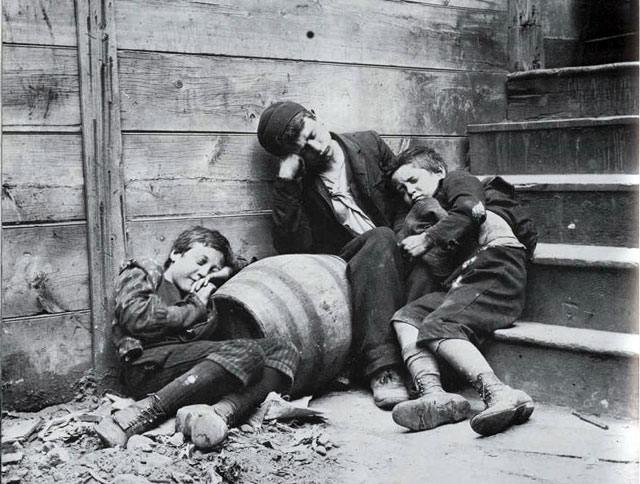
Collections of Riis’ photography can be viewed at Museum Syndicate and the Museum of the City of New York. Riis included many of his photographs in a book he published in 1890 called How the Other Half Lives: Studies among the Tenements of New York. (via petapixel)
From a 1925 issue of Quill magazine, a map of NYC’s Greenwich Village hand-drawn by Robert Edwards.
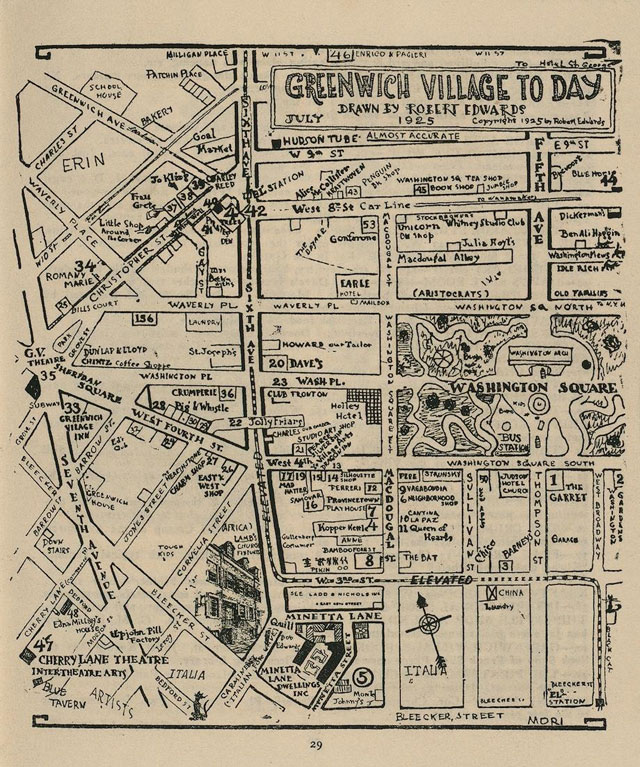
Newer posts
Older posts















Stay Connected